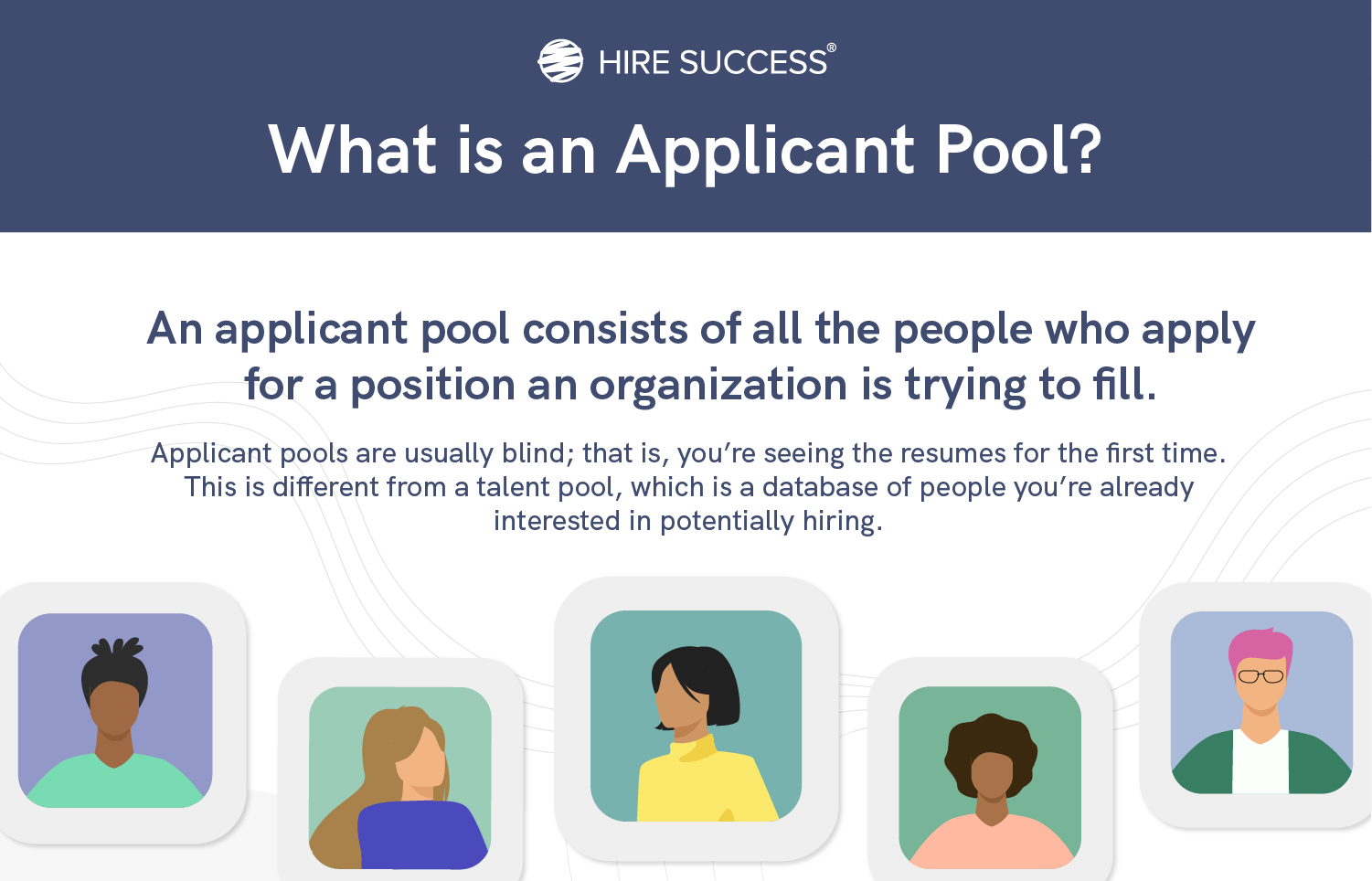Attracting an applicant pool is the first step to filling a position. Finding well-qualified applicants isn’t always as easy as it sounds. Because the value of the hire depends heavily on the quality of your applicant pool, it’s worth the time to ensure you have outstanding candidates before interviewing.
How do you ensure your applicant pool is filled with the best talent? It’s not guesswork. It’s science and process. Here’s what you need to know.
What is an applicant pool?

An applicant pool consists of people who apply for an open position. Building an applicant pool is only the first step in a hiring process filled with hundreds of applicants, many of which are unsuitable for the post advertised. That’s why organizing applicant pools can be messy without an efficient process and great tools.
Applicant pools are generally blind, meaning you’re seeing the resumes for the first time. This is different from a talent pool, which is a database of people you’re already interested in potentially hiring.
When you start with a large applicant pool, there’s a lot of work ahead to narrow your list down to a viable candidate pool with a list of qualified, suitable candidates that spell success in the open position.
Understanding your applicant pool
Filling a job with a successful candidate is challenging at the best of times — and with unemployment at an all-time low, it’s even more complex. The job market is volatile and fast-moving. Excellent candidates are snatched up fast, but hiring the wrong candidate because of a shallow candidate pool remains a costly mistake.
Understanding your applicant pool is more important than ever today. Here’s why:
- Reduce hiring costs and time-to-hire. A well-qualified applicant pool means you won’t waste time interviewing people not worth hiring. With a smart vetting process up front, you can short-list candidates before you meet them.
- Help reduce employee turnover. Flawed hiring procedures commonly result in increased employee turnover. Too often, new employees are either a bad fit for the position or a bad fit for your team. In the worst-case scenario, they can hurt your company culture or damage your reputation. Avoiding bad hires is a must.
- Improve the quality of candidates. One of the main issues with the traditional hiring process is seeing what the candidates want you to see. You have a better chance of identifying valuable employees and not just those who appear more charming if you understand the applicant pool.
- Increase diversity in the workplace. Diversity in the workplace can bring entirely new perspectives into play. Getting to know your potential hires based on personality, ethics, and capabilities before meeting them supersedes any preconceived ideas. It also helps you identify the best candidates based on success criteria.
- Add remote workers. Some areas still lack diversity and well-educated prospects, even in the United States. What if you have global customers, but your offices are in budget-friendly Kentucky? If you’re wondering how to get a diverse applicant pool and attract people with higher education, remote workers may be the best answer. You’ll also gain a much larger applicant pool.
5 steps to improve your applicant pool
Vetting your applicant pool can be time-consuming and time is a luxury. You’ll be prepared for some departures. However, it is not always possible. An accident, illness, or family emergency could pull a critical employee away. Additionally, essential lower-level workers might leave with short notice.
Fortunately, you can take steps in advance to ensure that your applicant pool is swimming with high-quality fish when you’re in a time crunch to fill jobs.
1. Be specific with job descriptions to gather the right type of applicants.
The first step in finding an improved applicant pool is bettering your job postings. To craft an effective job description, it’s important to understand the roles, skills, and responsibilities needed in the position. Your job postings should define the kind of person you’re searching for, the necessary skills and experience, and what their role will be within the organization.
You’ll also want to include something about your company culture to attract the right kind of personality. Some job seekers will thrive in a high-intensity setting, while others prefer a relaxed atmosphere. A good job description will discourage job seekers from looking elsewhere.
2. Define the ideal employee’s traits to attract the right personality type.
The ideal hire for your organization needs the right skills and experience, but a highly successful employee will have specific personality traits. Your job posting can explain both the technical skills and soft skills required for the position.
The tricky part is identifying necessary traits. The knowledge base for this task is already under your roof. Your top employees can help you establish a baseline for a successful hire. Since a bad hire can be surprisingly costly, defining success baselines for each position can save you tons of frustration, time, and money.
3. Publish job postings to the most relevant channels first.
After you’ve consulted your employee success baseline and crafted an effective job listing, you should carefully consider where to place the post. One effective way of figuring out the most relevant channel is to ask your recent hires where they found it.
While job boards are good for general positions and Linkedin is more likely to connect you with management and C-Suite candidates, you may find the best candidates in industry-specific groups on social channels. By discussing open positions in targeted social settings, you may pull inquiries from people only thinking about changing jobs or not actively looking.
Say goodbye to guesswork, hire with confidence
Try our platform for free and get unbiased, data-driven insights into candidates' personal qualities and abilities.
Book a Demo Try It Free4. Train existing employees and maintain a talent pool.
Another great way to improve the applicant pool is by maintaining a talent pool. Talent pools are a known quantity of people who have already caught your attention. Your talent pool may include:
- People who applied before and were on the shortlist
- People who work for competitors
- Employees of your organization with potential for promotion
- Employee recommendations
- Ex-employees who left without contention and might be willing to return
You may accidentally overlook great potential. Your best new hire might already be inside your organization.
The key to discovering hidden talents is to give your employees the support necessary to move up in their careers. Not only does this make successful hiring much faster and easier, but also ensures your new employee is a good fit. Lower-level positions are almost always easier to fill, and employees love a career path that includes the potential for advancement without having to find a new job.
5. Expand your search if you can’t find qualified local job applicants.
Your ideal job candidate might not be local. To find the right fit, you may need to expand your horizons and applicant pool. With remote becoming increasingly mainstream, there are benefits for employees and employers alike. If local talent is hard to find, consider updating your policies to include remote workers. It’s also a great way to get a diverse applicant pool. With no geographical boundaries, finding the perfect candidate should be far easier, and you’ll bring in greater diversity in the process.
How to organize and manage a large applicant pool
Bill Wednieski is a professional recruiter and Managing Director of The Headhunters, a corporate recruiting agency. He told Hire Success® about the difficulty of managing and making a decision with a large, highly qualified shortlist.
"I might find six or seven or eight different candidates that are all different and unique to make a really difficult decision for the employer,” Wednieski said. “Ideally, you want to get it down to the best three or four."
Wednieski also talked about how timing plays a role. Sometimes employers need to fill a position immediately to avoid losing business, and it can be a real challenge to successfully fill a position in a hurry. However, long time frames may present a problem as well.
“I had another [hiring situation] where a long-time employee is retiring at the end of May,” Wednieski said, “If I meet a candidate on March 2 and the company is not ready to hire until May 1, how do I keep the candidate excited about this role?”. The answer to this question will depend on a number of things, such as who the particular candidate is, what position they're applying for, and how the rest of your onboarding process is structured.
Managing large applicant pools can be a challenging and time-consuming process. Fortunately, there are tools to narrow down a shortlist of candidates with the best qualifications, experience, skills, and personality traits to fill the open position.
Shortlisting takes place after the hiring campaign produces results and before interviews begin. Some of the most efficient recruitment tools you can use are part of Hire Success®’ pre-employment testing system. You can find out what potential employees can do, discover hidden potential, and gain insight into questionable personality traits.
Using baselines established by regularly testing top employees, you can compare applicant answers to success profiles for the specific open position. It’s like knowing who is most likely to succeed in the job and fit into your team before you meet them for the first time.


